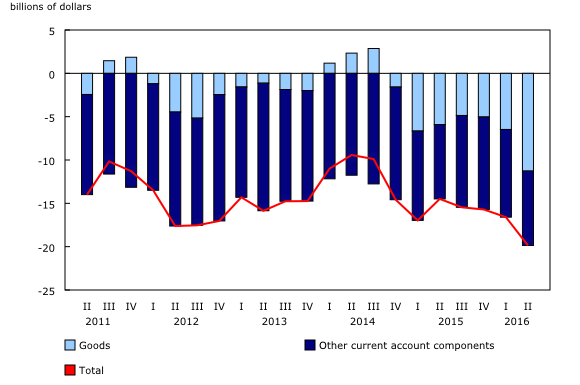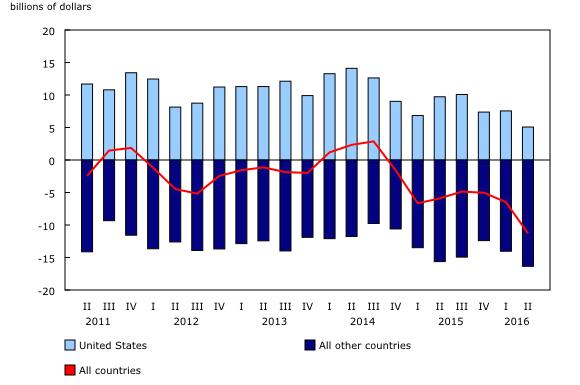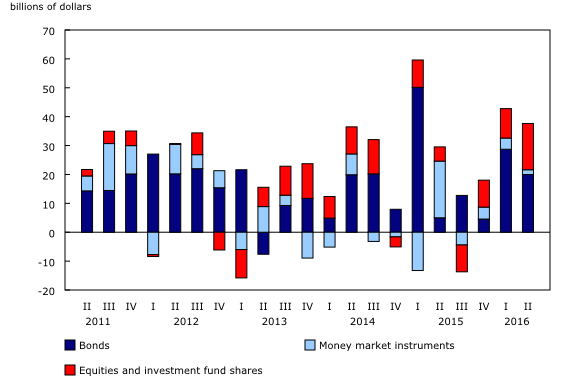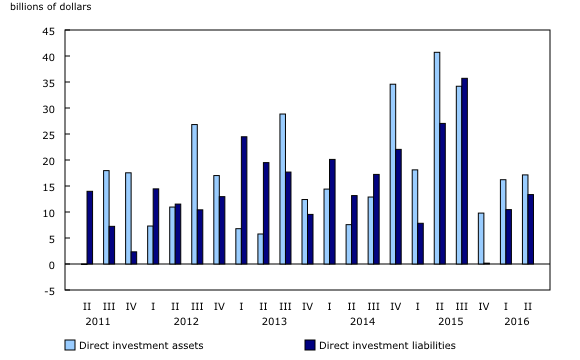Canada's balance of international payments, second quarter 2016
Archived Content
Information identified as archived is provided for reference, research or recordkeeping purposes. It is not subject to the Government of Canada Web Standards and has not been altered or updated since it was archived. Please "contact us" to request a format other than those available.
Released: 2016-08-30
-$19.9 billion
Second quarter 2016
Canada's current account deficit (on a seasonally adjusted basis) increased $3.3 billion in the second quarter to $19.9 billion, as the trade in goods deficit continued to widen.
In the financial account (unadjusted for seasonal variation), foreign investment in Canadian securities remained strong in the quarter and led the inflow of funds in the economy.
Current account
Deficit on trade in goods reaches a record high
The deficit on international trade in goods expanded $4.8 billion to a record $11.3 billion in the second quarter. This was the third straight quarterly increase of the goods deficit.
On a geographical basis, the goods surplus with the United States declined $2.5 billion to $5.1 billion, mostly on lower exports. The deficit with non-US countries rose $2.3 billion to $16.4 billion, the largest contributors being the United Kingdom and, to a lesser extent, Japan and Algeria.
Overall, exports of goods decreased $6.6 billion to $123.6 billion in the second quarter. Exports of motor vehicles and parts were down $2.3 billion on lower prices and volumes. Exports of consumer goods declined $1.7 billion on lower volumes. In contrast, exports of energy products increased $0.7 billion, as higher prices for crude oil and crude bitumen more than offset the decline in volumes exported.
Total imports of goods decreased $1.8 billion to $134.8 billion. The largest reduction was in consumer goods, down $1.0 billion on lower prices. Industrial machinery, equipment and parts also contributed to the decline, down $0.9 billion as a result of lower prices and volumes. Moderating this decrease, energy products advanced $1.2 billion, mostly on higher prices. Aircraft and other transportation equipment and parts gained $0.8 billion, all on higher volumes.
Trade in services deficit narrows
The overall deficit on international trade in services narrowed $0.3 billion to $5.1 billion in the second quarter, the lowest deficit since the end of 2011.
The reduction in the overall deficit reflected a gain of $0.2 billion in the commercial services surplus, mostly due to lower payments. After a $0.4 billion decrease in the first quarter, the travel deficit was unchanged at $3.6 billion in the second quarter. The number of Canadian travellers abroad and that of foreign travellers in Canada both changed slightly during the quarter.
Investment income deficit down
The investment income deficit was reduced by $0.6 billion to $2.9 billion in the second quarter, as receipts rose more than payments.
Income earned by Canadian direct investors on their assets abroad was the main contributor to the gain in receipts, with a $0.7 billion increase. Higher interest receipts on other foreign assets also contributed to the increase.
On the payments side, profits earned by foreign direct investors on their Canadian assets increased $0.8 billion, following low profits in the first quarter. The gain in the second quarter was moderated by lower payments of interest on Canadian bonds held by foreign investors. The Canadian dollar appreciated against its US counterpart in the second quarter compared with the first quarter.
Lower deficit in secondary income flows
The deficit in transactions on secondary income was reduced by $0.7 billion in the second quarter. This largely reflected higher transfer receipts by Canadian insurance companies on reinsurance services provided by foreign insurers, following the Fort McMurray wildfire.
Financial account
Foreign investment in Canadian securities remains strong
Foreign investment in Canadian securities reached $37.6 billion in the second quarter, following a $42.8 billion investment in the first quarter. The activity in the quarter mainly targeted securities from the private corporate sector.
Foreign investment in Canadian bonds amounted to $20.0 billion, led by purchases of new issues of private corporate bonds denominated in foreign currencies. In addition, foreign investors purchased $5.6 billion of Canadian government bonds, mainly secondary market purchases. Canadian long-term interest rates were down in the quarter.
Non-residents added $16.0 billion of Canadian equities to their holdings in the second quarter, the largest investment since the second quarter of 2004. More than half of the investment was in new Canadian shares issued to foreign portfolio investors, mostly resulting from cross-border mergers and acquisitions. Canadian stock prices were up 4.2% in the quarter.
Canadian acquisitions of foreign securities resume
Canadian investors added $13.7 billion of foreign securities to their holdings in the second quarter, following an $8.9 billion divestment in the first quarter.
Canadian acquisitions of foreign shares were $12.0 billion, almost evenly split between US and non-US instruments. Canadian investment in foreign debt securities slowed to $1.6 billion, as acquisitions of US bonds were moderated by sales of non-US foreign bonds in the quarter.
Overall, foreign investment in Canadian securities exceeded Canadian investment in foreign securities by $24.0 billion, largely contributing to the net inflow of funds into the economy in the second quarter.
Direct investment assets and liabilities up
Direct investment assets advanced $17.1 billion in the second quarter, slightly higher than the gain reported for the first quarter. Most of the investment in the quarter was the result of Canadian direct investment in foreign affiliates in the form of equity. As with the first quarter, roughly two-thirds of the direct investment was related to merger and acquisition activities. On a geographical basis, almost all the activity reflected an increase in direct investment assets in the United States.
On the liability side, direct investment grew $13.4 billion, compared with a $10.5 billion increase in the first quarter. Equity investment made by foreign parents in Canadian affiliates was the main contributor to the increase in the second quarter. More than half of the direct investment in Canada was from US investors.
Currency and deposits assets and liabilities increase
The other investment category of the financial account generated a $1.1 billion inflow of funds in the second quarter. A significant increase in currency and deposits held by non-residents in Canada was almost entirely offset by growth in those held by Canadian residents abroad.
Note to readers
Definitions
The balance of international payments covers all economic transactions between Canadian residents and non-residents in three accounts: the current account, the capital account and the financial account.
The current account covers transactions in goods, services, compensation of employees, investment income and secondary income (current transfers).
The current account data in this release are seasonally adjusted. For information on seasonal adjustment, see Seasonally adjusted data – Frequently asked questions.
The capital account covers capital transfers and transactions in non-produced, non-financial assets.
The financial account covers transactions in financial assets and liabilities.
In principle, a net lending (+) / net borrowing (-) derived from the sum of the current and capital accounts corresponds to a net lending (+) / net borrowing (-) derived from the financial account. In practice, as data are compiled from multiple sources, this is rarely the case and gives rise to measurement error. The discrepancy (net errors and omissions) is the unobserved net inflow or outflow.
For more information on the balance of payments, consult the Frequently asked questions section in the System of macroeconomic accounts module of our website. The module also presents the most recent balance of payments statistics.
Real-time CANSIM table
Real-time CANSIM table 376-8105 will be updated on September 7. For more information, consult the document, Real-time CANSIM tables.
Next release
Balance of international payments data for the third quarter will be released on November 29.
Products
The Methodological Guide: Canadian System of Macroeconomic Accounts (13-607-X) is available from the Browse by key resource module of our website, under Publications.
The User Guide: Canadian System of Macroeconomic Accounts (13-606-G) is also available from the Browse by key resource module of our website, under Publications. This publication will be updated to maintain its relevance.
Contact information
For more information, contact us (toll-free 1-800-263-1136; 514-283-8300; STATCAN.infostats-infostats.STATCAN@canada.ca).
To enquire about the concepts, methods or data quality of this release, contact Denis Caron (613-808-2278; denis.caron@canada.ca), International Accounts and Trade Division.
- Date modified:





